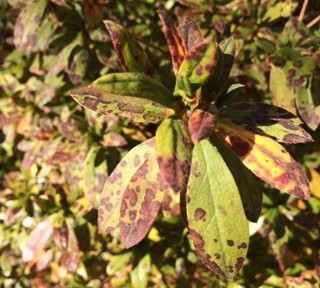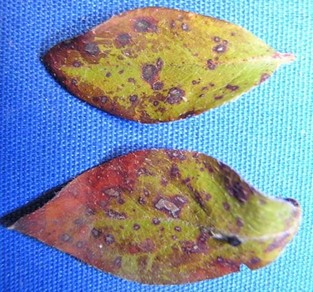Disease Notes
Contact
Sherrie Smith
Plant Diagnostician
Phone: (479) 575-2727
Email: ssmith@uada.edu
Jason Pavel
Diagnostician
Phone: (479) 575-7257
Email: jpavel@uada.edu
University of Arkansas System Division of Agriculture
Cralley Warren Building
Room 16
2601 N. Young Ave.
Fayetteville, AR 72704
Azalea
by Sherrie Smith and Jason Pavel

Azalea Leaf Spot – Cercospora handelii
Photo by Mitch Spanel, Lawn Doctor of West Little Rock
Azaleas often look a little ragged this time of year. They may have freeze injury and older leaves that have spots. Infections by Cercospora handelii usually begin in the spring although symptoms may not appear until fall or in the following spring on one year old leaves. At least two months pass between infection and the appearance of the lesions.
Symptoms are brown to red circular to irregular spots on the lower leaves. Centers of the spots become gray with age. Tiny black fruiting bodies may be seen in the center of the spots with a hand lens. Although severe infections can cause leaf drop late in the season, fungicides are usually not necessary. Rake and destroy fallen leaves. Avoid overhead irrigation. If chemical control is desired, apply thiophanate methyl, chlorothalonil, myclobutanil, or mancozeb to protect leaves before infection in the spring.
Take Aways
- Rake and destroy fallen leaves
- Apply fungicides in the spring before infection
- Avoid overhead irrigation

Azalea Leaf Spot – Cercospora handelii
Photo by Sherrie Smith, University of Arkansas Cooperative Extension
This work is supported by the Crop Protection and Pest Management Program [grant no. 2017-70006- 27279/project accession no. 1013890] from the USDA National Institute of Food and Agriculture.